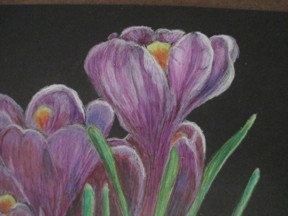These flowers are more than purple. Like all colors in
nature, they are more a blend of color than a pure pigment.
 Layers of purples are between layers of white and a touch of
red. The stamens are shades of orange-red to light yellow.
Layers of purples are between layers of white and a touch of
red. The stamens are shades of orange-red to light yellow.
Between each layer, I stop and using a stump, blend each
layer to the previous layers. I also want to blend the stem of the flowers
(purple) to the green stem, shading through white. This is how the flowers
grow, and I want to continue this.
I also want to bring back the white highlights on the crocus
itself and its leaves.
I do use a blending stick for some of this. This is a pencil
that is pure wax. Using it helps two colors of colored pencil blend into each
other.
Then I do burnish the entire picture, using the burnishing
tool, rather than the paper stump. This brings a nice polish and shine to the
drawing. It helps it jump away from the paper.
I really like the contract between the dark paper and the vivid flowers.








